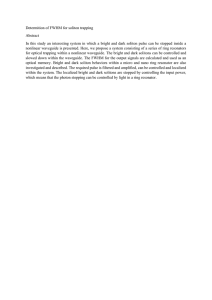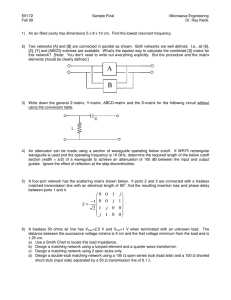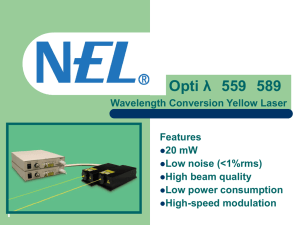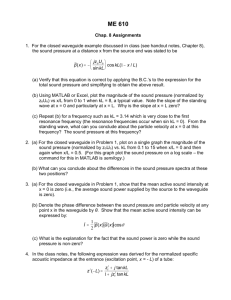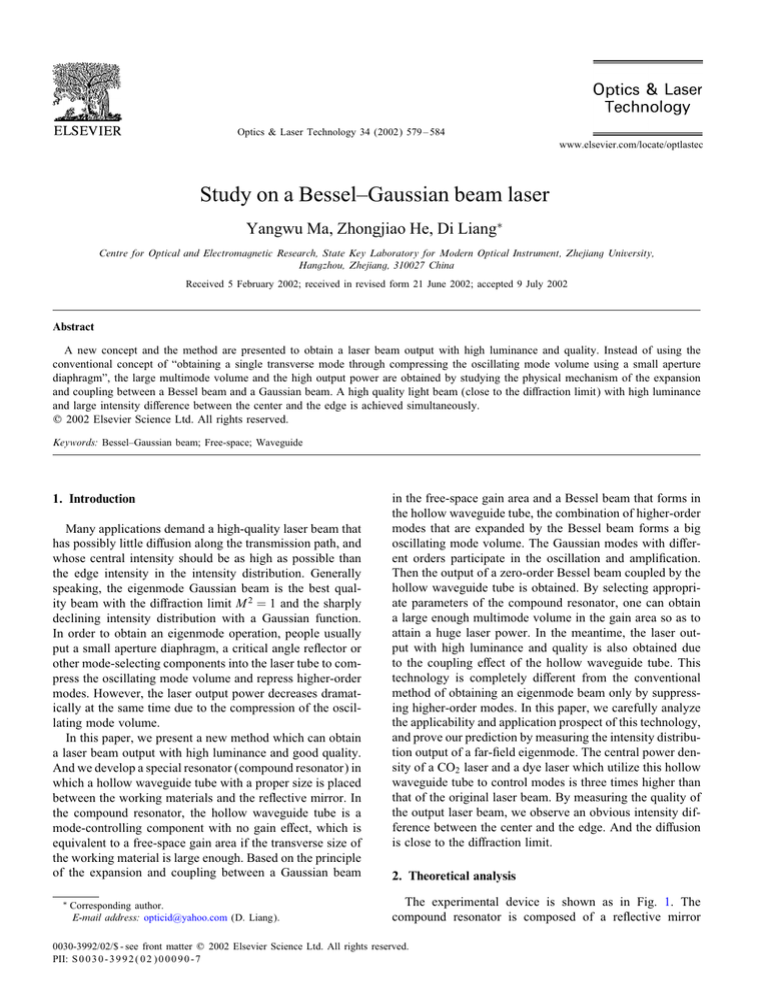
Optics & Laser Technology 34 (2002) 579 – 584
www.elsevier.com/locate/optlastec
Study on a Bessel–Gaussian beam laser
Yangwu Ma, Zhongjiao He, Di Liang∗
Centre for Optical and Electromagnetic Research, State Key Laboratory for Modern Optical Instrument, Zhejiang University,
Hangzhou, Zhejiang, 310027 China
Received 5 February 2002; received in revised form 21 June 2002; accepted 9 July 2002
Abstract
A new concept and the method are presented to obtain a laser beam output with high luminance and quality. Instead of using the
conventional concept of “obtaining a single transverse mode through compressing the oscillating mode volume using a small aperture
diaphragm”, the large multimode volume and the high output power are obtained by studying the physical mechanism of the expansion
and coupling between a Bessel beam and a Gaussian beam. A high quality light beam (close to the di<raction limit) with high luminance
and large intensity di<erence between the center and the edge is achieved simultaneously.
? 2002 Elsevier Science Ltd. All rights reserved.
Keywords: Bessel–Gaussian beam; Free-space; Waveguide
1. Introduction
Many applications demand a high-quality laser beam that
has possibly little di<usion along the transmission path, and
whose central intensity should be as high as possible than
the edge intensity in the intensity distribution. Generally
speaking, the eigenmode Gaussian beam is the best quality beam with the di<raction limit M 2 = 1 and the sharply
declining intensity distribution with a Gaussian function.
In order to obtain an eigenmode operation, people usually
put a small aperture diaphragm, a critical angle reBector or
other mode-selecting components into the laser tube to compress the oscillating mode volume and repress higher-order
modes. However, the laser output power decreases dramatically at the same time due to the compression of the oscillating mode volume.
In this paper, we present a new method which can obtain
a laser beam output with high luminance and good quality.
And we develop a special resonator (compound resonator) in
which a hollow waveguide tube with a proper size is placed
between the working materials and the reBective mirror. In
the compound resonator, the hollow waveguide tube is a
mode-controlling component with no gain e<ect, which is
equivalent to a free-space gain area if the transverse size of
the working material is large enough. Based on the principle
of the expansion and coupling between a Gaussian beam
∗
Corresponding author.
E-mail address: opticid@yahoo.com (D. Liang).
in the free-space gain area and a Bessel beam that forms in
the hollow waveguide tube, the combination of higher-order
modes that are expanded by the Bessel beam forms a big
oscillating mode volume. The Gaussian modes with di<erent orders participate in the oscillation and ampliFcation.
Then the output of a zero-order Bessel beam coupled by the
hollow waveguide tube is obtained. By selecting appropriate parameters of the compound resonator, one can obtain
a large enough multimode volume in the gain area so as to
attain a huge laser power. In the meantime, the laser output with high luminance and quality is also obtained due
to the coupling e<ect of the hollow waveguide tube. This
technology is completely di<erent from the conventional
method of obtaining an eigenmode beam only by suppressing higher-order modes. In this paper, we carefully analyze
the applicability and application prospect of this technology,
and prove our prediction by measuring the intensity distribution output of a far-Feld eigenmode. The central power density of a CO2 laser and a dye laser which utilize this hollow
waveguide tube to control modes is three times higher than
that of the original laser beam. By measuring the quality of
the output laser beam, we observe an obvious intensity difference between the center and the edge. And the di<usion
is close to the di<raction limit.
2. Theoretical analysis
The experimental device is shown as in Fig. 1. The
compound resonator is composed of a reBective mirror
0030-3992/02/$ - see front matter ? 2002 Elsevier Science Ltd. All rights reserved.
PII: S 0 0 3 0 - 3 9 9 2 ( 0 2 ) 0 0 0 9 0 - 7
580
Y. Ma et al. / Optics & Laser Technology 34 (2002) 579 – 584
l
z
M1
M2
M2(∞)
M1(R)
M2
W
D
W
W
laser
L
Fig. 1. Setup for “waveguide/free-space” compound cavity: M1 —spherical
reBective mirror; M2 —plane output mirror; D-beam-calibre discharge
tube; W —hollow waveguide tube.
M1 , a large aperture discharge tube D, a hollow waveguide tube and an output mirror M2 . The discharge tube D,
with a large enough diameter, is full of working gases, that
is, equivalent to a free-space gain area of the oscillating
mode.
The di<erence between the compound resonator (shown
in Fig. 1) and the common waveguide oscillating resonator
[1] lies in the fact that the waveguide tube and the large
aperture discharge tube work independently as di<erent
components in the compound resonator, whereas in the
common waveguide resonator, the waveguide tube is not
only a component for the mode-controlling and the beam
guidance, but also a container for the gas discharge simultaneously. Within the compound resonator, therefore, the
mode controlling e<ect of the waveguide tube decides the
output of the low-order waveguide mode. However,
the whole active mode volume of the compound resonator
is not conFned by the size of a waveguide tube because a
waveguide tube has no gain e<ect.
The oscillating mode that satisFes the self-consistence
condition of a compound resonator must be the low-order
waveguide eigenmode that may transmit in a waveguide
tube with a low loss. At the same time, it must have the
“Laguerre–Gaussian” distribution in the free-space gain area
so as to be coupled eMciently by the reBective mirror. One
of the e<ective methods to analyze the mode Feld distribution and the resonator loss is a digital approach [2] using
the matrix computing. That is a kind of iterative method
that can be used for obtaining the lowest-order oscillating
mode with the arbitrary geometrical alignment and its corresponding loss. In other words, the lowest order waveguide
mode transmits through the resonator continuously until the
reproduced Feld distribution can be achieved after every
transmission.
Fig. 2 is equivalent to the expanded Fgure of a
“free-space-waveguide-lens series” shown in Fig. 1.
Assuming an output mirror M2 to be a plane mirror
and close to the oriFce of the waveguide tube, we can
ignore the distance between the waveguide tube and the
M2 and then simplify Fig. 2 further to be the equivalent
free-space-waveguide-lens system with a half symmetrical
structure presented in Fig. 3.
l
d
z
z
l
d
Fig. 2. Equivalent free-space-waveguide-lens system (a): M1 —spherical
reBective mirror; M2 —plane output mirror.
W
A
➀➁
f(R/2)
B
➂➃
2l
M5
W
A
➄➅
2l
M1
M2
M3 M4
M5
M1
Fig. 3. Equivalent free-space-waveguide-lens system (b): f—equivalent
lens of M1 mirror; W —hollow waveguide tube; M1 –M5 —alternate matrixes.
At the oriFce of waveguide tube, the waveguide mode is
calculated numerically through a transformation matrix M1
to the limited grid [3]. This means to expand the waveguide
EH1m mode ① to the “Laguerre–Gaussian” TEM mode Feld
② by calculating the numerical integral of M1 as follows:
a
r m (r)n (r) dr:
(1)
(M1 )mn = 2
0
In Eq. (1), is the waveguide tube radius; n (r) and m (r)
are the normalized functions of a waveguide mode and
a free-space mode, respectively. The “Laguerre–Gaussian”
mode ② transmits through an equivalent lens f and goes
back to the oriFce B of the waveguide tube by “Frenel–
Kirrchof ” di<raction integral. This process can be calculated through a diagonal matrix M2 . On the condition of the
reBective mirror radius R → ∞; M2 can be presented in a
much more concise form
(M2 )mn = mn exp[ − i2m tan−1 (4z=k!02 )];
(2)
where k is the wave vector and !0 is the waist radius of
the “Laguerre–Gaussian” light beam. When transmitting to
the oriFce B, the free-space mode is a TEM mode with the
expanded facula ! ¿ !0 and a limited radius R . This mode
must be transformed to a TEM mode with a waist facula !0
through the matrix M3 :
∞
dr 2 Lm (r 2 )Ln (r 2 )exp(−qr 2 ): (3)
(M3 )mn = (2=!!0 )
0
In the equation above, = 2=!02 ; = 2=!2 ; q = 1=!02 +
1=!2 − ik=2R,
! = !0 [1 + (4z=k!02 )2 ]1=2 ;
R = 2z[1 + (k!02 =4z)2 ];
Y. Ma et al. / Optics & Laser Technology 34 (2002) 579 – 584
where z is the distance between the oriFce B and a reBective
mirror; Lm and Ln are Laguerre polynomials of the order
m and n, respectively. M4 , the inverse matrix of M1 , then
transforms this free-space mode to the waveguide mode once
again.
Shown as the following, M5 is a transmission matrix of
the waveguide mode in the waveguide tube:
2
(1=ka2 )(Re vn =ka )]
(M5 )mn = mn exp[ − u1m
i 2
2
2
exp − (u1m − u11 )(l=ka )(1 + 2Im vn =ka ) : (4)
2
Beginning from A (shown in Fig. 1), the oscillating mode
Feld achieves the reproduction of the original Feld distribution in the place A after a round of reciprocation. The Fnal
round-trip matrix is
M = M 5 M 4 M 3 M2 M 1 ;
(5)
MXi = Ai Xi :
(6)
M can be worked out from Eq. (6). Xi , the eigenvector
of M , represents a Feld distribution of the oscillating mode
in the compound resonator. !i is the eigenvalue of M and
the total loss of the compound resonator is attained from the
following equation:
Li = 1 − |!i |2 :
(7)
The results of the numerical calculation show that the mode
Feld distribution and the resonator loss of the compound
resonator depend on the parameters of the resonator structure, including the length of the waveguide tube l, the tube
radius , the reBective mirror radius R, the distance z and
the parameter, !0 =. Actually, !0 = is the most important
parameter among them. Although the matrix eigenvalue !i
and !0 = are independent of each other and the value of
!0 = seems arbitrary, the number of TEM modes that can
be expanded is Fnite in fact. The sub-matrices M1 ; M2 ; M3
show that the value of !0 = is related to the active mode
volume in the free-space gain area and the convergence of
the free-space mode when it returns to the waveguide.
Abrams [4] has even assumed that there only allowed the
existence and transmission of the EH11 mode, i.e. the waveguide mode with the lowest order, in the waveguide tube.
Consequently, if the reBective mirror is placed properly, the
98% energy of EH11 mode radiates into TEM00 mode with
a waist facula !0 = 0:6435. This method is probably the
most convenient for lasers with waveguide resonator. For
the “waveguide-free space” compound resonator, however,
the most interesting parts are the entire volume of the expanded TEM mode in the free-space gain area and the total
loss in the process that the TEM mode is re-coupled to the
waveguide mode again. By the numerical calculation, the
waveguide loss of the EH1m modes in the resonator is very
close to the loss of the EH11 mode. The much more practical concern therefore is that the resonator mode should be
the linear combination of the EH1m modes. This means that
an appropriate value of !0 = should make the EH1m mode
581
coupled into the free-space TEM0m mode at the optimal
eMciency.
Based on the expanded equation of the entire energy Q
of EH1m modes, we can obtain
Q=
∞
|Ap (!0 )|2 = |A0 (!0 ) + A1 (!0 )
p=0
+ A2 (!0 ) + · · · |2 :
(8)
In the above equation, Ap (!0 ) is the amplitude of the p-th
free-space expanded mode.
Based on Abram’s assumption, we can also obtain
@A0 (!0 )
= 0:
@!0
This is to say that when !0 ==0:6435, the 98% energy of the
EH11 mode is coupled into the TEM00 mode, and the rest of
2% energy radiates into the TEM0m mode. Concerning that
the resonator mode is the linear combination of low-order
EH1m modes (for instance: EH11 ; EH12 ; EH13 ), however, we
then select the another value of !0 = in order that the largest
value of Ap (!0 ) of Eq. (8) appears in the latter terms of
this equation. For the term A2 (!0 ) as an example, we obtain
!0 = = 0:490 by calculating the equation @A2 (!0 )=@!0 = 0.
The energy distribution in this way becomes: 89% energy
of the EH11 mode is coupled into TEM00 mode; 84% energy
of the EH12 mode is coupled into the TEM01 mode; 73%
energy of the EH13 mode is coupled into the TEM02 mode.
Obviously, the selection of !0 = = 0:490, compared with
!0 = = 0:6435, is able to guarantee much larger oscillating
mode volume in the free-space gain area.
According to the calculation, the energy proportion of
each waveguide mode in the linear combination of EH1m
modes declines promptly with the enhancement of the number of the modes: m. The Frst three modes almost contain the
entire energy of the resonator modes, and especially EH11
mode covers the highest proportion. Hence, from experiments we observe the output of the quasi-Gaussian ground
mode with the far-Feld distribution both at the two values
of !0 = mentioned above.
The characteristic of the “waveguide-free-space compound resonator” is that the EH1m mode conFned by the
waveguide tube can be expanded to free-space modes of
di<erent orders at the oriFce of the waveguide tube. Those
modes are ampliFed and then form a large active mode
volume in the process of the transmission in the free-space
gain area. When the re-coupled waveguide modes feed back
to the oriFce of the waveguide tube, its energy must be
larger than the energy produced in the oscillation of single
Gaussian ground mode. The processes of expansion, ampliFcation and coupling between free-space modes and the
waveguide modes produce a new mode-selecting concept
of “multimode oscillation and single mode output”. Hence,
we provide a method to achieve a laser output with high
power and single mode operation.
582
Y. Ma et al. / Optics & Laser Technology 34 (2002) 579 – 584
3. Experimental methods and results
3.1. The parameters of the compound resonator
The selection for the radius a and the length l of a waveguide tube in the compound resonator should satisfy the
matrix M5 . This means, these parameters should make the
lowest order waveguide mode transmit with a small enough
loss in the tube, and simultaneously avoid the oscillation
of higher-order modes. Generally, the Fresnel number N
should be selected from N = =L& = 0:2 ∼ 1: L is the length
of the compound resonator and & is the wavelength. The
tube length l may have an impact on the proportion of the
energy, the transmission loss and the number of low-order
modes that the waveguide tube can possibly form. We Fnd
that the impact is not so obvious if the ratio l= is over 20
in our primary experiments.
The three parameters, the reBective mirror radius R and
distance z and !0 =, decide the oscillating mode volume
and the coupling loss of the reBective mirror. In the early
stage of study, we still adopt Abram’s results [5] and think
that the parameters of the low coupling loss area: z = f and
R = 2f(f = !2 =&; f: confocal parameter.), may be one
of the applicable conFgurations for the compound resonator
(There maybe exists better conFguration.). In order to compare the inBuence of the values of !0 = to the oscillating
mode volume, according to the calculative results, two values of !0 = are selected as: (1) !0 = = 0:6435, corresponding to @A0 (!0 )=@!0 = 0; (2) !0 = = 0:55, corresponding to
@A1 (!0 )=@!0 = 0.
For the selection of the diameter DT of the big aperture
discharge tube which is placed between the reBective mirror
and the oriFce of waveguide tube, one should consider the
largest oscillating mode volume that can exist and accommodate possibly, the di<usion cooling e<ect of the working
materials and the transverse distribution of the inverted population density in the discharge tube. Research [6] shows
that it is an appropriate selection when DT and the diameter Di of the oscillating light beam satisfy the relationship
D T = e 2 Di .
3.2. Experimental results
In the experiment, the diameter of the discharge tube is
DT = 28 mm, the length is L = 90 cm, the mixed ratio of the
working gases is CO2 : N2 : He : Xe = 1 : 1:25 : 5 : 0:5, the
total pressure is 20 Torr, the discharge current is 35 mA,
the waveguide tube radius is 3:5 mm; the tube lengths l
are 10, 50, 100, 200, 400, 1200 mm, respectively.
The experimental setup for measuring the beam proFles
(shown in Fig. 4) is composed of a small aperture diaphragm, a power meter and an oscillagraph. The laser beam
emits towards the power meter horizontally and the small
aperture diaphragm makes a vertical motion up and down
in front of the power meter (the motion distance is over the
power meter
output beam
Dbeam
small aperture
diaphragm
oscillagraph
Fig. 4. The setup for measuring the output power and beam proFles.
beam diameter). The signals out of the power meter are input to an oscillagraph when that small aperture diaphragm
Fnishes a scanning. The beam proFles are observed and
then printed out from the oscillagraph. After removing the
small aperture diaphragm, we obtain the total output power.
And the average power density is also obtained through the
equation of Daverage = Ptotal =Dbeam (Daverage : average power
density; Ptotal : total output power; Dbeam : beam diameter)
Experimental results show that when there is no waveguide tube in the resonator, i.e. only common CO2 laser, the
output pattern of the typical multimode is observed and the
average power density is 21 W=cm2 on the conditions of
the reBective mirror radius R=3 m, the output mirror radius
R = ∞ and the total length of the resonator L = 1:8 m.
When a diaphragm with radius aT = 6 mm (equivalent to
N = 1:5) is placed in the resonator, the output pattern of
the quasi-TEM00 mode is observed and the average power
density is 36W=cm2 .
The diaphragm in the resonator is then replaced by a
waveguide tube with radius = 3:5 mm. At the value of
!0 = = 0:6435 and based on the low loss condition of z =
f; R = 2f, the distance z between the waveguide oriFce
and the reBective mirror is Fxed at z = f = 1:5 m and the
mirror M1 radius R is 3 m long.
For the short waveguide tube 7×10 mm, it is impossible
to form the e<ect of the waveguide mode just as our expectation. Instead, it becomes a small Fresnel number resonator
virtually [7]. The typical ring ground mode pattern (Fig. 5)
with the circle symmetrical distribution, similar to the mode
pattern output of the confocal unstable resonator [8], can be
observed. Since there is a very large di<raction loss in the
small aperture resonator, the laser power reduces obviously
and the average output power density is only 10 W=cm2 .
For a waveguide tube 7 × 50 mm as a replacement,
we observe the mode competition that the homogeneously
distributed waveguide modes and the ring ground mode of
a small aperture resonator appear alternately. The output
power density of the waveguide modes is about 30 W=cm2 .
Besides, observation shows that the luminance of the waveguide modes is much higher than that of the ring modes.
When placing a waveguide tube 7 × 100 mm in the resonator, we obtain a stable output of the single mode and observe the obvious enhancement of the facula luminance. The
output power density is 60 W=cm2 , twice as much as that of
Y. Ma et al. / Optics & Laser Technology 34 (2002) 579 – 584
rel. intensity
Table 1
Output mode patterns and the average output power density with di<erent
lengths of the waveguide tubes (!0 = = 0:6435; a = 3:5 mm; z = f =
1:5 m; R = 3 m)
far-field
1
0.5
Length of the Output mode pattern
waveguide
tube (mm)
Average output
power density
(W=cm2 )
10
10
50
100
−3
−2
−1
0
r
1
2
583
Ring ground mode pattern with
the circle symmetrical distribution
Homogeneously
distributed
waveguide modes and the ring
ground mode (appearing alternately)
Stable single mode
30 (the waveguide modes)
60
3
Fig. 5. Output beam intensity and facula of small-N cavity.
1
far-field
rel. intensity
1
rel. intensity
far-field
0.5
0.5
−4 −2
−4 −2
0
r
2
4
Fig. 6. Output beam intensity and facula of “waveguide free-space” cavity
(!0 = = 0:6435; f = 1:5 m; R = 2f = 3 m; z = f = 1:5 m).
the common resonator. Fig. 6 is far-Feld intensity distribution of the output beam, with the pattern of the quasi-TEM00
mode.
If replaced with a longer waveguide tube, the laser has the
same stable single mode output. In the experiment, a waveguide tube 7 × 100 mm is purposely put into the resonator
and the total length of the resonator L = 3100 mm. When
the mirror M1 radius R = 3 m, a common plane-concave resonator became an unstable resonator [9], whereas the compound resonator can still keep a stable single mode output,
which conFrms the operation mechanism of the “compound
resonator” as well. Table 1 shows the output mode patterns
and the average output power density with di<erent lengths
of the waveguide tubes.
0
r
2
4
Fig.
7.
Output
intensity
and
facula
compound
(!0 = = 0:55; f = 1:1 m; R = 2f = 2:2 m; z = f = 1:1 m).
cavity
For comparison, we use a waveguide tube with a same
size, 7 × 100 mm, to test the beam output on the conditions of the second value of !0 = = 0:55, the corresponding
confocal parameter f=1:1 m, the distance z=f=1:1 m and
the reBective mirror radius R = 2:2 m. If other parameters
are invariable, we observe that the laser output power is obviously higher than that of the Frst value of !0 = = 0:6435.
Both the similar quasi-ground mode with a far-Feld intensity distribution and a homogeneous facula pattern are still
achieved (shown in Fig. 7). We also measure the oscillating mode volume in the free-space gain area at two different values of !0 =, respectively, and observe that the
facula size between the mirror M1 and the discharge tube D
is larger than the expected size of TEM00 mode. The facula
size at a value of !0 = = 0:55 is much larger than the one
at a value of !0 = = 0:6435, which conFrms the theoretical
analysis.
584
Y. Ma et al. / Optics & Laser Technology 34 (2002) 579 – 584
M 2 , i.e. times-di<raction-limit-factor [10], can be deFned
as the following:
d* · +* :
M2 =
(9)
4&
In the above equation, d* is the diameter of the beam
waist, +* is the divergence angle of the far-Feld beam. The
M 2 of the output beam of the compound resonator at a value
of !0 = = 0:55 is measured experimentally, and the result is
M 2 = 1:106. But the M 2 of the output beam of the common
resonator is M 2 = 1:5.
4. Conclusion
The essence of the principle and the method proposed in
this paper is the multimode oscillation and a single mode
output. This means that the lowest order mode output is
obtained by coupling free-space modes of di<erent orders
which participate in the oscillation, not just suppressing
higher-order modes as the loss. The output beam quality
and the power density are therefore both raised greatly. Our
study has indicated that the output characteristics of the
resonator are not only related to the parameter !0 =, but
also close to other structural parameters. For examples, a
higher oscillating mode volume and the output power have
been achieved if adopted the “waveguide/free-space” mixed
unstable resonator structure [11,12]. The most appropriate
resonator structure can be attained through further theoretical and experimental research. Surely speaking, this novel
technology can be applied to the solid-state, gas and liquid
lasers other types of lasers, etc. Especially for the high power
lasers which are not easy to output high quality beams, the
transverse-Bow CO2 , CO lasers, chemistry lasers for examples, it has an extensive application prospect.
Acknowledgements
The authors are especially grateful to Professor Sailing
He for valuable discussions.
References
[1] Smith PW. A waveguide gas laser. Appl Phys Lett 1971;19:132–3.
[2] Degnan JJ, Hall DR. Finite-coperture waveguide-laser vesouator.
IEEE J Quantum Electron 1973;QE-9:901–2.
[3] Gerlach R, Wel D, Amer NM. Coupling eMciency of waveguide
laser resonators formed by Bat mirrors: analysis and experiment.
IEEE J Quantum Electron 1984;QE-20:948–63.
[4] Chester AN, Abrams RL. Mode lasers in hollow-waveguide laser.
Appl Phys Lett 1972;21:576–8.
[5] Abrams RL, Chester AN. Resonator theory for hollow-waveguide
laser. Appl Opt 1974;13:2117–25.
[6] Ma YW, Han YH. Measurement of stimulated emission cross of
00◦ 1–10◦ 0 transmission in a CO2 laser. Chin J Lasers 1988;15:
278–84.
[7] Ma YW, Chen YQ. The laser. China: Press of Zhejiang University,
1994.
[8] Barone SR. Optical resonators in the unstable region. Appl Lett
1967;6:861–3.
[9] Roper VG. The use of confocal unstable resonators in a double
rogowsk TEA CO2 laser. Opt Laser Tech 1976;8:13–6.
[10] Document ISO/TC172/SC9/WG1/N56. Milan, Italy, 11/1993.
[11] Abramski KM, Colley AD, Backer HJ, Hall DR. Power Scaling
of large-area transverse radio frequency discharge CO2 laser. Appl
Phys Lett 1989;54:1833–5.
[12] Jackson PE, Baker HJ, Mall DR. CO2 large-area discharge laser
using an unstable-waveguide hybrid resonator. Appl Phys Lett
1989;54:1950–2.


